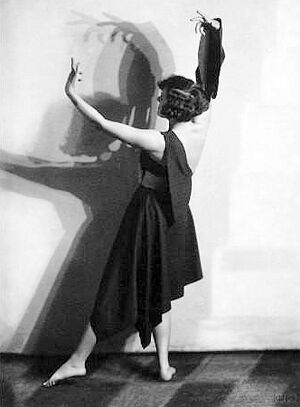Gerd Neggo facts for kids
Gerd Neggo (born November 9, 1891 – died September 1, 1974) was a famous Estonian dancer. She was also a dance teacher and a choreographer. A choreographer is someone who creates dance routines. Gerd Neggo helped bring new styles of dance to Estonia. She is known for starting modern dance and mime in her home country. Mime is a type of performance where stories are told using only body movements, without words.
She learned different ways of dancing, including a method by Émile Jaques-Dalcroze. She also trained with Rudolf von Laban in Germany. In 1924, she opened her own dance studio in Tallinn, Estonia. There, she taught and promoted modern dance and mime. These styles were often based on classical ballet. Later in her life, during a difficult time when Estonia was under Soviet rule, she moved to Sweden with her husband. Today, a special scholarship is given every year to honor her important work in Estonian culture.
Contents
Gerd Neggo: A Pioneer of Dance
Gerd Neggo was born in Kuressaare, Estonia, in 1891. From a young age, she was interested in movement and expression. She traveled to learn from the best dance teachers of her time.
Early Life and Training
Gerd Neggo first studied a method called Émile Jaques-Dalcroze. This method teaches people to respond to music with their bodies. She learned this in Stockholm, Sweden. After that, she went to Hamburg, Germany. There, she studied modern dance and mime with Rudolf von Laban. Laban was a Hungarian dancer who had a background in classical ballet. He taught a new way of dancing that was more free and expressive.
Opening Her Own Dance School
After becoming an expert in modern dance, Neggo returned to Tallinn. In 1924, she opened her very own dance school. She started teaching students the modern dance techniques she learned from Laban. Her school became a very important place for dance in Estonia.
Gerd Neggo created many solo and group dances. She also put on pantomimes, which are like plays told through mime. She and her dance group performed at the Estonian Drama Theatre. They often performed in plays for children and young people. These performances included modern dance parts. They helped promote creative thinking and expression. Many famous artists trained at her school. These included Ida Urbel, who later started her own dance company. Other notable students were Salme Reek, Helmi Tohvelman, and Edith Oltrop.
Life During Difficult Times
In 1925, Gerd Neggo married Paul Olak. He was a theater manager, journalist, and writer for plays. In 1944, Estonia faced a difficult time. The country came under Soviet rule. Because of this, Gerd Neggo and her husband moved to Sweden.
They first stayed in refugee camps. They worked hard to find jobs and connect with other Estonians in Sweden. They played a big part in creating cultural activities for Estonians living in the camps. Paul Olak passed away in 1949. In 1952, Gerd Neggo performed with other Estonian artists. This performance took place at the Royal Swedish Opera in Stockholm. Gerd Neggo lived in Stockholm until she passed away in 1974.
Her Lasting Legacy
Gerd Neggo is remembered for her important role in Estonian dance. She helped start modern dance in Estonia. She also made sure it was seen as an important part of the country's culture. To honor her, the Estonian Cultural Endowment for Folk Culture started an annual scholarship in 2011.
This scholarship is given to artists who teach modern dance. It helps them pay for training. The scholarship is awarded through the Estonian Dance Education Union. It provides money for training in Estonia or €1000 for training abroad. This helps new generations of dancers continue her legacy.


